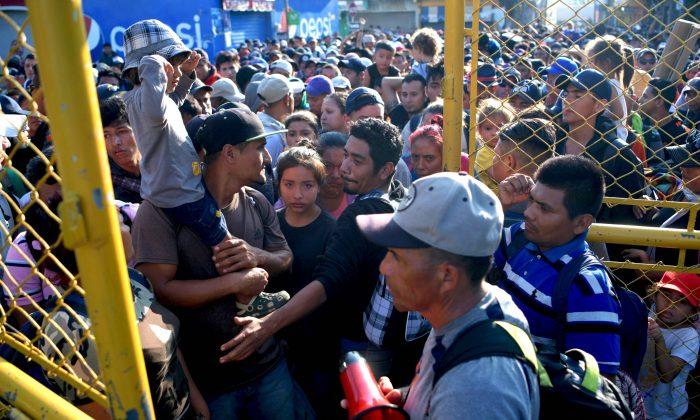As the official network of the anti-Trump “Resistance,” CNN is known these days less for the journalistic prowess that led it to dominate cable news than for journalistic posturing and preaching. It’s anti-Trump 24/7/365, and the abandonment of its core values has cost it dearly, in terms of both ratings and reputation.
The worst offender is anchor Don Lemon, who has a two-hour broadcast every weeknight. In any given segment, no matter what the subject or its relevance, Lemon seems incapable of not bringing up that he is a gay black man who was a victim of child sex abuse and that he believes Trump represents both a personal and a political affront to him because of who he is—although he never quite explains why that is.
But lately, Anderson Cooper has been getting in his own angry, indignant, and condescending licks. The moralizing is cut with a self-righteous refusal to acknowledge facts and realities that challenge his biases and those of the network.
This, of course, isn’t the way journalism is supposed to work, skepticism being the mother’s milk of the news business. But in the age of the anti-Trump, skepticism has taken a backseat to proselytism and agitprop. A lot of newsrooms don’t do skepticism anymore if it means one of the following:
• challenging liberal pieties that have come to define the discourse on immigration, especially illegal immigration and the white-hot issue of Central American migrant caravans exploiting our asylum system to win residency in the United States; or
• having to report factual realities and evidence that might actually validate and legitimize Trump’s policy position—and the harsh rhetoric he uses to articulate them—or highlights the substantive validity of what he is saying, however badly phrased or misframed.
On Twitter, President Donald Trump insisted that the caravan represented a “national emergency” and that “criminals and unknown Middle Easterners are mixed in.” Later that day, he repeated the charge in the Oval Office with the media present. The claim drew scorn and outrage from much of the press, with Trump’s insinuation that terrorists were using the caravan as cover being seen as a ploy to fan fear and induce public panic in the face of the looming midterm elections.
Repeating a pattern established during the 2016 campaign, the media focused more on Trump’s scary rhetoric than on any underlying truth. There was also a refusal to correct the blind spots and biases that corrupted coverage of the Great Family Separation Crisis on the Texas border with Mexico just a few months earlier. Central American border-crashers still wore a halo, idealized in such a way to avoid acknowledging the following:
• that many were not, in fact, fleeing political persecution but were seeking economic opportunity;
• that the vast majority would attempt to defraud authorities on the border with bogus asylum claims;
• that hostile elements from outside the hemisphere might be in the mix.
The “AC 360” segment epitomized the eye-rolling condescension and indignant scoffing at Trump, and at any and all available facts that might have substantiated his insistence on undesirable Middle Eastern infiltration. In his opener, Cooper told the audience: “A senior U.S. counterterrorism official tells CNN there’s no evidence that ISIS or any other Sunni terror groups are trying to get into the country by coming across the southern border. No evidence. ... No evidence of terrorist infiltration in the migrant caravan now making its way through Mexico. Zero, none.”
He was leading the broadcast with this, he explained, “because simple facts matter and the quiet truth bears repeating.” With just two weeks to go until the midterm elections, Trump “has chosen to fill the public arena with the exact opposite of a quiet truth or simple facts and he’s doing it in a way that seems designed to scare people,” he said, adding that the president of the United States is “out there loudly, repeatedly, unabashedly spreading falsehoods.”
Cooper followed with a video from the field, but only aired it after apologizing for doing so. “We’re only going to show this video sparingly because you can make the case that to play wall-to-wall pictures of thousands of men and women making their way north only serves the president’s purpose of making it appear more threatening than it actually is,” Cooper maintained.
CNN correspondent Bill Weir said that all he saw were “impoverished and genuine people” streaming north and Mexican villagers greeting them with freshly cooked tortillas and Christian gestures of welcoming a stranger. Trump was wrong to smear them, one migrant said, telling Weir through a translator: “We’re not terrorists. We just want to work. We’re running away from a form of terrorism in Honduras.”
Joining Cooper was CNN’s Van Jones, who dismissed Trump’s warning as a “talking point,” and a toxic one at that. Jones took pains to point out that “just because someone is Middle Eastern—of course, there are no Middle Easterners there—but doesn’t mean that they’re bad, it doesn’t mean that they’re terrorists.
“You know, we’re in this world now where Trump can say ‘Middle Eastern,’ and everybody then immediately somehow begins to think of ’terrorist.' Most of the terrorists that we, instances we’ve had in the United States, are not being committed by Middle Eastern people, by Muslims, they’re being committed by right-wing extremists in our country. So this is lie, on top of lie, on top of lie, wrapped in lies, and then with some lies on top of it.”
Jones said he appreciated the effort to check out the facts but still found it unseemly. “You’re talking about sick kids, you’re talking about pregnant women. They’re not demanding they’re being—they’re asking for help, they’re applying for asylum,” he said.
CNN’s resident supporter of Trump, Steve Cortes, said there might, in fact, be something behind the president’s charge. Jones countered with an extraordinary burst of virtue-tripping and guilt-mongering.
“The idea you’re going to participate in this smear campaign against these sick, hungry, scared people, it’s not fair, it’s not right. And I’m sad to hear you do it,” Jones said.
Later on in the broadcast, Cooper introduced Washington Post columnist Max Boot, who said that Trump was “firing up the base” with “appeals to prejudice and bigotry.”
‘It Is Absolutely True’
For students of asymmetrical warfare, the use of refugee flows as cover to insert a fifth column of insurgents wouldn’t be surprising in the least. And it takes less than a minute of googling to find information on how Middle Easterners have, in fact, been showing up on the southern border with increasing frequency, courtesy of sophisticated and very far-flung human smuggling networks. And a significant complement of them has been found to have ties to terror groups who find our lax asylum-seeking procedures quite appealing.A former reporter who traveled through the Middle East in the years after 9/11 to report on vulnerabilities in our immigration and asylum systems that terrorists can use to their advantage, Bensman joined the intelligence community after getting a masters from the Naval Postgraduate School, where he wrote a thesis titled “The Ultra Marathoners of Human Smuggling: How to Combat the Dark Networks that Can Move Terrorists Over American Land Borders.” I met him in San Antonio last spring on a reporting trip I took through the Rio Grande Valley just before the last border crisis. He is laconic in that shy Texas cowboy kind of way, but tells it like it is.
“It is absolutely true that people who have terrorist backgrounds or backgrounds in terrorism do get here, and that Middle Easterners showing up on the border seeking asylum are very much part of the mix,” Bensman said. “Three to four thousand every year on the border with Mexico alone. Trump is right about that and a lot of people on the inside who know he’s right can’t say anything out loud, because the intelligence is highly classified and because it throws a dark political cloud over the broader issue of Latin American immigration. But he is right.”
In the past, such migrants were known to U.S. border agents as “other than Mexicans,” or OTMs for short, or “exotics” in Texas law-enforcement slang. But the term used now to classify them is “special interest aliens,” or SIAs. According to Bensman, there are currently about 25 countries in the Middle East, South Asia, and the Horn of Africa, from which these SIAs originate.
If the migrants’ fingerprints are on file and their names are on a watch list, their real names might “pop.” But that’s an extremely “serendipitous occurrence,” Bensman explains.
“In fact, most have never been fingerprinted, and usually show up with no ID at all—no passport, no driver’s license, no birth certificate—no nothing. They say ‘asylum,’ they give you a name and a story and that’s it,” he said. “So, we have no idea of basic things like who they really are, where they come from, and whether their claim for asylum is true. It’s impossible to even get to step one.”
Tagging the migrants as SIAs at least pushes them through a different set of security checks, Bensman says.
“If they say they are Lebanese, we’ll call FBI, ICE Intelligence, our embassy in Lebanon. Go through their pocket litter, dump their cell phones, call their home governments, stuff like that. If we can clear up their identities and they are not listed anywhere, we can put them back on track,” he said.
If not, the migrant is put into a detention facility to sort it all out, although many are released before that because of limited “bed space,” with some detainees being freed before they are even adequately interviewed. Bonds are low and the ankle monitors they are fitted with are often cut off as soon as they leave the detention facility. Bensman says that to be released pending the adjudication of your case and, even more, to win actual asylum, is much coveted, allowing “release into the interior of the U.S. with permission to live and travel abroad and, after six months, permission to work.”
In the first months after assuming office, Trump’s initial tough rhetoric did give SIA migrants pause, and did lower the SIA headcount.
“All it took was for him to say ‘Muslim ban,’ and that ‘indefinite detention’ would replace ‘catch and release,’” Bensman said.
A Highly Sophisticated Threat
In fact, the threat level associated with SIAs is now higher than before Trump took office. The places that many are coming from—Yemen and Syria—are more conflict-ridden and dysfunctional, limiting the on-the-ground cooperation these governments will offer. And though no one has ever quantified how many terrorists were actually “embedded” in the Syrian refugee flow into Europe, the number of deadly terror incidents involving refugees with links to the ISIS terrorist group, who were purposely operationally deployed, stands as “proof of concept” in the intelligence community.Americans tend to be exceptionalists about Islamic terrorism wracking Europe—France, Germany, and Belgium in particular, Bensman notes. “But there’s no reason that what has happened over there can’t happen here. They came into Europe on fake Syrian passports or some other bogus documentation and then they disappeared.” As European experience shows, winning asylum or taking advantage of the asylum process is critical, buying them time to do whatever it is they are planning to do. “Once they get in, the clock starts ticking.”
Another reason the threat is worse is because our guard is down. “After 9/11, there was an agreement throughout the government and the counterterrorism community: ‘Thou shalt stop terrorists at the border,’ which translated into SIAs being stopped on their journeys, no matter what it took. But since then, vigilance has faded.”
Organizations such as Judicial Watch have cried wolf about terror groups crossing the border to attack targets like the highly secretive Fort Huachuca in Arizona, which Bensman blames on them “mistaking intel for truth.” The highly classified nature of the intelligence also plays a role in the fading of America’s post-9/11 vigilance.
When SIA investigations do open up, they have to have operational security and have to “stay secret,” so that the terrorist organizations overseas who may be controlling the SIA don’t shut down or ”go dark” online. These restrictions on access and information-sharing wind up impairing a general awareness of the problem in the wider intelligence community and the politicians who oversee it. Still another reason America’s guard is down is the fact that there have been no attacks on American soil of the scale and scope of 9/11 since that day.
The human-smuggling networks that SIAs use are highly sophisticated, “very cosmopolitan and very multicultural,” as Bensman describes. “The kingpins are multilingual with dual citizenships or dual residencies. You might have a Brazilian who has official residency in Jordan, or a Jordanian with legal residency in Mexico. Or the other way around. Smugglers based in East Africa will have contacts with the Brazilian consulates in Kenya. That sort of thing.”
Smugglers often have lawyers working for them here; Chinese “snakeheads,” which is what Chinese smugglers are called in American law-enforcement parlance, will have Chinese-American lawyers.
“They are very smart, they know the law, and they are able to coach clients through the ‘credible fear’ process. They know the asylum process cold and are completely current on the political trends in the countries the migrant is supposedly coming from, so they can craft informed narratives and cover stories that might pass muster with interrogators on the border,” he said.
They also keep an ear close to the ground. “They’ll know that they’re cutting off ankle bracelets in Phoenix or that there is a bed space crunch in the Laredo sector, which will lower the risk of detention or shorten whatever detention is imposed,“ he said, adding, ”Their grapevine is very alive.”
Smugglers at this end are highly motivated; failure is not an option. Unlike Mexicans or Central Americans who pay their smugglers pretty modest amounts, SIAs pay their smugglers a fortune—up to $50,000. And unlike Mexicans who can try many times again if they are thrown back, SIAs have one shot.
“If a client gets indefinite detention that results in deportation, it is a huge and very costly stain on the smuggler’s business reputation,” Bensman said. “It’s a very big failure of the smuggler’s ‘service package.’”
These smugglers also have an advantage because the legal cases against them are hard to make, with complex case law demanding a lot of evidence. They are usually pursued by the investigations wing of ICE, which has a problem right now with getting cooperation on the ground in many places like Somalia, Syria, or Yemen because “there is no one on the ground to interface with.” The only advantage international authorities have against the smugglers is that unlike terrorist organizations that employ them, the smuggling organizations are vulnerable to what the intelligence community calls “decapitation.”
Corruption and Smuggling
To get into a Central American country, you need to have some kind of identity document and some kind of visa, which are usually discarded in the final leg of the journey just shy of the U.S. border.The visas are actually real, purchased from corrupt Central American consular officials. There’s no problem getting them over there—money can get you anything. In Africa, a Brazilian consulate will sell them; in the Middle East, it might be the Guatemalan “honorary consul” in Jordan who flies his country’s flag over the furniture store he runs, Bensman says.
On one reporting trip, when he was still a journalist, a Mexican consul told Bensman that he was offered an arrangement that could net him $10,000 a month for bulk purchases. Bensman told one Central American diplomat that a couple of Iraqis had said they could get visas from her without proof of ID or documents—just $750.
“That’s what they told you?” the consul reportedly responded. “Get out!”
After securing travel documents, the next step for SIAs is to fly to a country in South America: Brazil, Ecuador, Peru, or Venezuela. For a while, in the 2000s, Ecuador dropped requirements for visas altogether, which turned it into a “staging platform” for SIAs from Pakistan. Venezuela and Bolivia aren’t very cooperative with U.S. authorities and don’t allow ICE to even operate there.
Once SIAs make their way into Panama, it’s easy to keep on trucking. In Panama, smugglers often tell them to surrender to authorities, go into detention camps, get fed, get medical treatment, and get some rest for the rest of the trip north. Guatemala, says Bensman, is “one big smuggling enterprise” where “almost everyone seems to be involved in smuggling.” Smugglers own the borders, he says; the Ministry of Immigration doesn’t even pretend to control them.
“The Guatemalan border guards hardly look at you and the Mexican guards don’t look either,“ Bensman said. ”The only interference the migrants experience is being shaken down by cops at regular intervals along the route, which requires SIAs to carry a lot of pocket change for bribes.”
Bensman said it’s hard to get officials to break down how many SIAs are snagged at official ports of entry along the border and how many are apprehended going around those ports after swimming or floating across the Rio Grande. His guess is that 2 out of 3 go through official crossing points. Bangladeshis tend to go around the ports of entry while Somalis go through them, he says, adding he has no idea why or what that means.
Contrary to CNN’s snickering, Bensman says that the governments of Honduras, Guatemala, and Mexico are combing through the caravans and are, in fact, finding dubious characters. Among them are MS-13 gang members and, yes, Middle Easterners of suspicious provenance, though whether or not they are terrorists hasn’t been established. Caravan operators would be cooperating with these efforts, because it’s in their interest to keep the caravans “pure” in order to minimize political obstruction on the ground.
‘An Inconvenient Truth’
As a relatively new national security fellow at the Center for Immigration Studies, one of the first things Bensman has done is put together a list of recommendations for what U.S. authorities can do to “reduce the border’s vulnerability to European-style entry by terrorists posing as migrants or by migrants predisposed to later commit acts of terrorism.”“The good news is that America doesn’t have to go down Europe’s path,” Benson said via email regarding the paper. “There are concrete steps that lawmakers can and should take to avert terror attacks by land border entrants.”
Chief among these steps is an insistence on putting SIAs in “indefinite detention” and providing the bed space for that. At present, “there is no indefinite detention for SIAs, although there certainly should be,” he said at the Center for Immigration Studies. “The caravans get going when they hear there is a bed space problem in the system. That’s what motivates them.”
Bensman says he’s heartened that the White House is beginning to “dial into” the SIA problem, although the media’s offhand dismissals and snide derision of what Trump has said on Twitter and in the Oval Office is dispiriting to many in the intelligence community who’ve spent their entire careers focused on the problem, especially those in the CIA, Customs and Border Protection, and ICE’s Office of Homeland Security Investigations.
Bensman frets that “it’ll take some kind of attack on the order of 9/11, with SIAs at the center, before we work up the will to do anything.”
Right now, the SIA issue is an “inconvenient truth that the left would rather not be there, so they just try to blow it off,” he said.
“But when a Big One happens, the people now scoffing at Trump will be written up in the same way that people were ridiculed for saying airplanes would never fly.”




